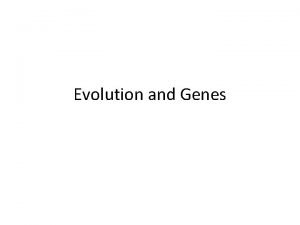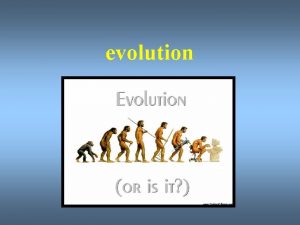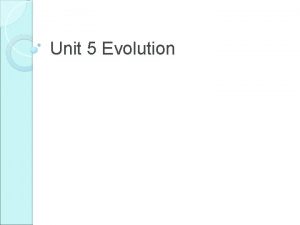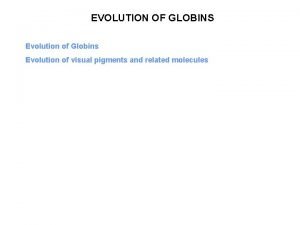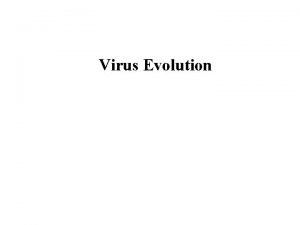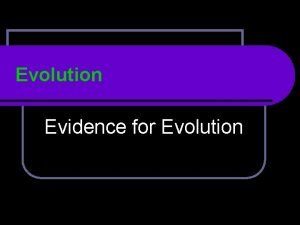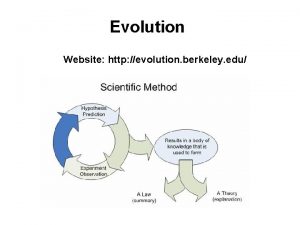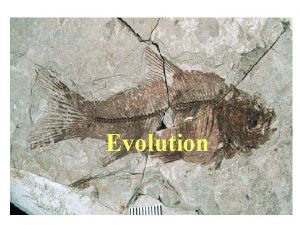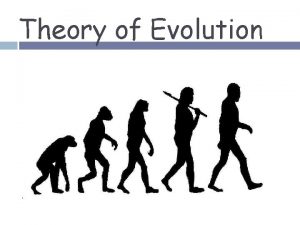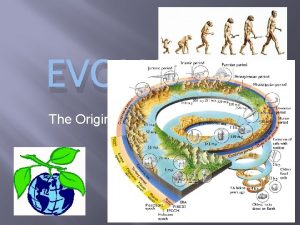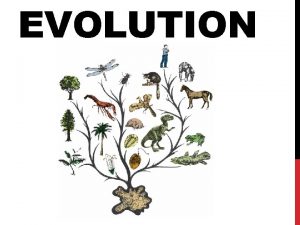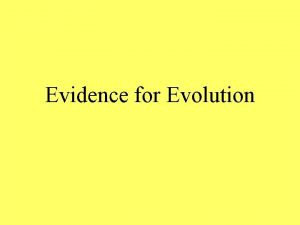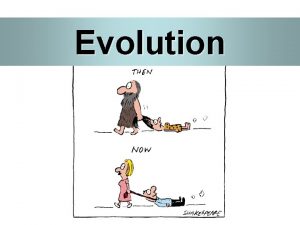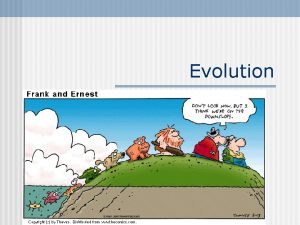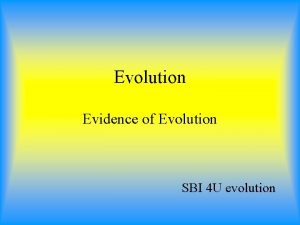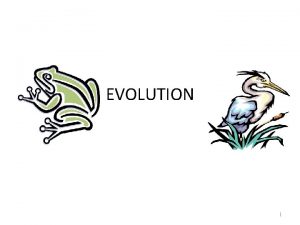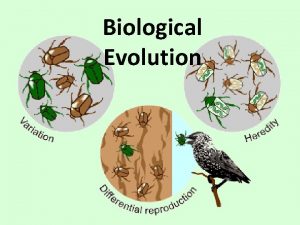Evolution Evolution What is evolution It is the






























- Slides: 30

Evolution

Evolution • What is evolution? – It is the process of biological change by which descendents come to differ from their ancestors

Scientists • Scientists who began studying evolution: – Linnaeus (1700’s) • Developed classification system of organisms • Proposed that organisms arose from hybridization

Scientists • Buffon (1700’s) – Used evidence of past life – Proposed that species shared ancestors instead of arising separately – Proposed earth was much older than 6000 years

Scientists • Erasmus Darwin (1731) – Proposed all living things were descended from a common ancestor – Later expanded upon by his grandson

Scientists • Lamarck (1809) – Didn’t believe in extinction – Species evolved instead – Proposed that changes in environment caused behavior to change – Organism passes on these traits to offspring – “Inheritance of acquired characteristics”

Charles Darwin • Darwin took a trip to the Galapagos Islands aboard the HMS Beagle • He studied the inhabitants of the island

What did Darwin find?

Charles Darwin • Findings and conclusions: – Variation among species – Led him to believe species adapt to their environment – Adaptation- feature allows an organism to better survive in an environment – Leads to change in populations over time

Examples of Adaptations

horned lizard pistol shrimp aye archer fish

Charles Darwin • Natural Selection – Individuals inherit beneficial adaptations and produce more offspring than others

Charles Darwin • 4 principles of natural selection: 1. Variation - Differences among organisms 2. Overproduction - More offspring increases chance for survival 3. Adaptation - Certain variations allow to survive better 4. Descent with Modification - Over time, more individuals in the population will have the beneficial traits

Natural Selection Variation Adaptation Overproduction Descent with Modification

Fossil Evidence • No fossil evidence that contradicts evolution has been found • Allows us to see transitions of species over time

Anatomical Evidence • Homologous structures – Features that are similar in structure, but different in function in different organisms – Supports common descent

Anatomical Evidence • Analogous structures – Structures that perform similar function

Anatomical Evidence • Vestigial structures – Unused features – Structure had a function in early ancestor – Helps support common ancestry and evolution

Molecular Evidence • All living things have DNA • Organisms carry pseudogenes – Genes that do not function (vestigial) • Cells have very similar proteins – Marine worms have same proteins in the eye as vertebrates Ø Comparison of milk protein in whales and hippos: • Hippo TCC TGGCA GTCCA GTGGT • Humpback Whale CCC TGGCA GTGCT

Match the structure Homologous, analogous, or vestigial B A C

Population Distributions • Normal Distribution – Frequency of a certain phenotype is near the mean

Population Distributions • Directional Selection – Selection favors phenotypes at one extreme – Population shifts toward advantageous trait

Population Distribution • Stabilizing Selection – The intermediate is favored and becomes the most common

Population Distribution • Disruptive Selection – Both extreme phenotypes are favored

Genetic Drift • Bottleneck Effect – Occurs after an event greatly reduces the size of a population – Ex. Overhunting of elephant seals

Genetic Drift • Founder Effect – Occurs after a small # of individuals colonize a new area – Ex. Emerald ash borer

Sexual Selection • Occurs when certain traits increase mating success • Two types: • Examples: – Intrasexual • Physical competition among males – Intersexual • Displays among males Giraffe fight Bird display – Intersexual

Long-tailed Widowbird Male Female

Evolutionary Classification • Cladogram – Evolutionary tree that proposes how species may be related to each other through common ancestors • Clade – Group of organisms that share certain traits

Evolutionary Classification Cladogram for modes of transportation: Bicycle Car Motorcycle Airplane On foot walking bicycle motorcycle car airplane wings motor wheels Passengers enclosed
 101012 bằng
101012 bằng Thiếu nhi thế giới liên hoan
Thiếu nhi thế giới liên hoan Hát lên người ơi
Hát lên người ơi Tia chieu sa te
Tia chieu sa te Một số thể thơ truyền thống
Một số thể thơ truyền thống Sơ đồ cơ thể người
Sơ đồ cơ thể người Tư thế ngồi viết
Tư thế ngồi viết Cong thức tính động năng
Cong thức tính động năng Số.nguyên tố
Số.nguyên tố đặc điểm cơ thể của người tối cổ
đặc điểm cơ thể của người tối cổ Tỉ lệ cơ thể trẻ em
Tỉ lệ cơ thể trẻ em Các châu lục và đại dương trên thế giới
Các châu lục và đại dương trên thế giới độ dài liên kết
độ dài liên kết ưu thế lai là gì
ưu thế lai là gì Các môn thể thao bắt đầu bằng tiếng chạy
Các môn thể thao bắt đầu bằng tiếng chạy Thẻ vin
Thẻ vin Hát kết hợp bộ gõ cơ thể
Hát kết hợp bộ gõ cơ thể Cái miệng nó xinh thế chỉ nói điều hay thôi
Cái miệng nó xinh thế chỉ nói điều hay thôi Từ ngữ thể hiện lòng nhân hậu
Từ ngữ thể hiện lòng nhân hậu Trời xanh đây là của chúng ta thể thơ
Trời xanh đây là của chúng ta thể thơ Tư thế ngồi viết
Tư thế ngồi viết Thế nào là giọng cùng tên? *
Thế nào là giọng cùng tên? * Voi kéo gỗ như thế nào
Voi kéo gỗ như thế nào Thể thơ truyền thống
Thể thơ truyền thống Khi nào hổ con có thể sống độc lập
Khi nào hổ con có thể sống độc lập đại từ thay thế
đại từ thay thế Thế nào là hệ số cao nhất
Thế nào là hệ số cao nhất Diễn thế sinh thái là
Diễn thế sinh thái là Vẽ hình chiếu vuông góc của vật thể sau
Vẽ hình chiếu vuông góc của vật thể sau Thế nào là mạng điện lắp đặt kiểu nổi
Thế nào là mạng điện lắp đặt kiểu nổi






























